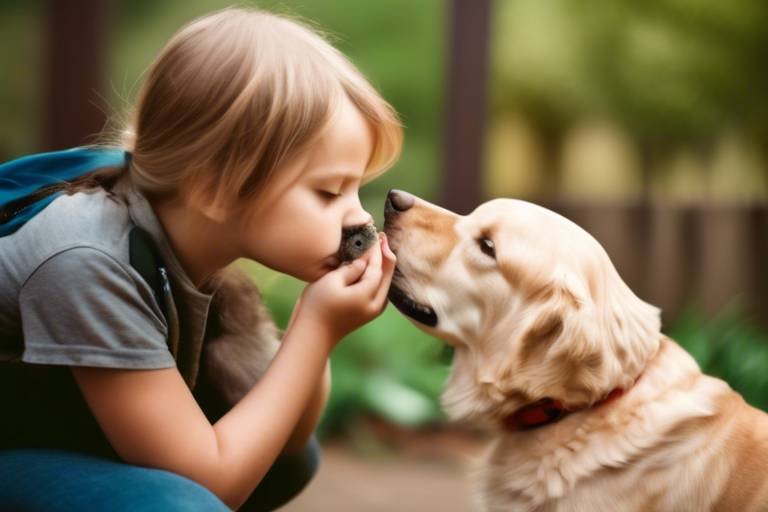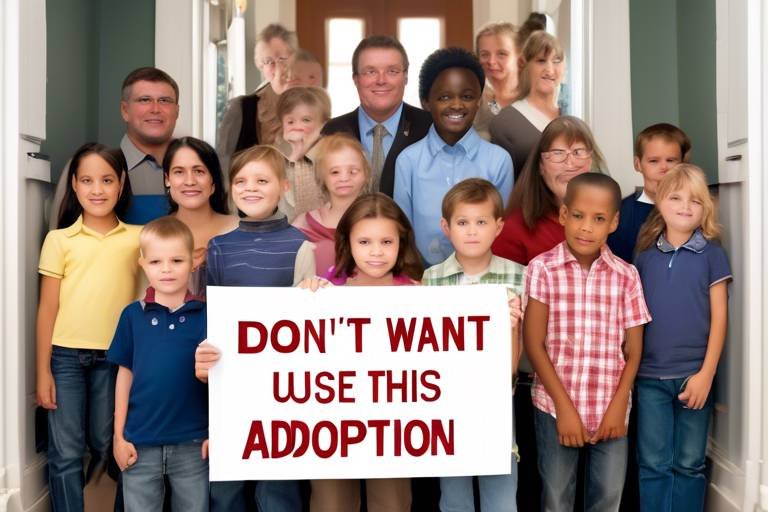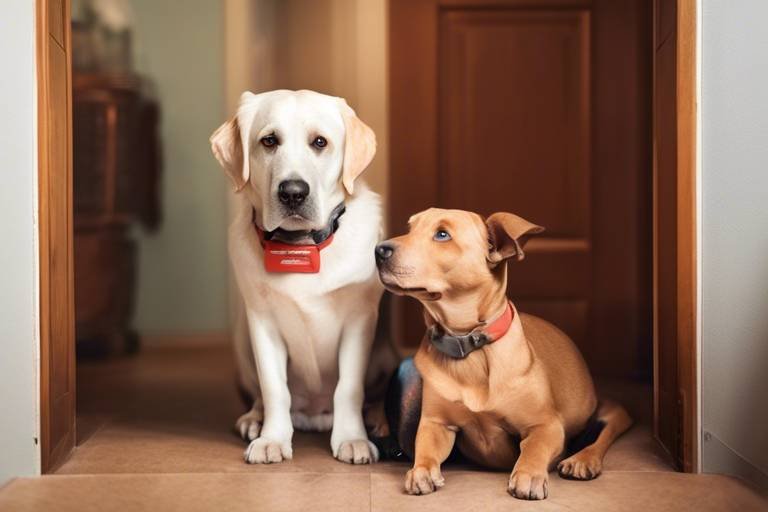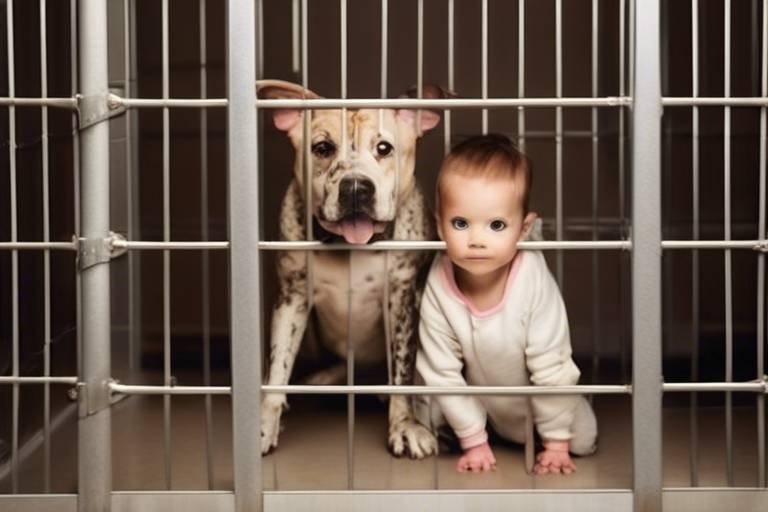How to Start a Pet Adoption Blog
Starting a pet adoption blog is not just about sharing cute pictures of furry friends; it's about creating a community that advocates for the love and care of pets in need. If you're passionate about animals and want to make a difference, this guide will walk you through the essential steps to launch your blog successfully. From choosing a niche that resonates with your audience to creating engaging content that inspires action, we’ll cover everything you need to know. So, grab a cup of coffee, and let’s dive into the exciting world of pet adoption blogging!
Identifying a specific niche within the vast realm of pet adoption can significantly enhance your ability to connect with your audience. Think of your niche as a cozy corner of the internet where like-minded animal lovers can gather. Some popular niches include:
- Breed-Specific Adoption: Focus on specific breeds and their unique needs.
- Rescue Stories: Share heartwarming tales of pets finding their forever homes.
- Pet Care Tips: Offer advice on how to care for adopted pets.
By honing in on a niche, you not only target your audience more effectively but also establish yourself as an authority in that area. This can lead to more engagement and a loyal readership.
Once you've chosen your niche, it’s time to set up your blog. This step is crucial as it lays the foundation for your online presence. You’ll need to consider several factors, including the blogging platform, domain name, and hosting options. Let’s break it down.
Selecting the right blogging platform is essential for ease of use and functionality. Here’s a quick comparison of popular options:
| Platform | Pros | Cons |
|---|---|---|
| WordPress | Highly customizable, vast plugin options | Steeper learning curve for beginners |
| Blogger | User-friendly, free | Limited design options |
| Wix | Drag-and-drop interface, visually appealing | Less flexibility in terms of features |
Choosing the right platform can make or break your blogging experience, so take your time to evaluate which one suits your needs best!
WordPress is often the go-to choice for bloggers due to its flexibility and extensive range of plugins. With WordPress, you can easily optimize your blog for search engines, manage content effortlessly, and even customize your site with themes that reflect your style. If you’re serious about blogging, WordPress is definitely worth considering.
Your domain name is your blog's online identity, so choose wisely! A memorable and relevant domain name not only helps with branding but also makes it easier for readers to find you. Here are some tips for selecting a great domain name:
- Keep it short and simple.
- Make it relevant to your niche.
- Avoid numbers and hyphens.
Once you’ve settled on a name, register it and secure your online presence!
A visually appealing blog can attract and retain readers. Think of your blog's design as the storefront of your online shop. You want it to be inviting and easy to navigate. Consider using themes that are clean and responsive, ensuring they look great on both desktop and mobile devices. Highlight your content effectively by using clear headings, engaging images, and a layout that guides readers through your posts.
Remember, in the blogging world, content is king. It's what keeps readers coming back for more. You can create various types of content, including articles, videos, and infographics, to engage your audience and promote pet adoption. Think about what resonates with your readers and tailor your content accordingly.
Storytelling is a powerful tool that can create emotional connections with your audience. Sharing compelling rescue stories or personal experiences can inspire others to adopt pets. Think of your blog as a platform to narrate these heartwarming tales that tug at the heartstrings. When readers can relate to your stories, they're more likely to take action!
Incorporating visuals can enhance your blog posts significantly. Images, infographics, and videos not only break up text but also make your content more engaging and shareable. Make sure to use high-quality images that reflect the joy of pet adoption, and don’t hesitate to include videos that showcase the personalities of the pets you’re advocating for.
Fostering a community around your blog can enhance engagement and support. It’s not just about writing; it’s about creating a space where readers feel connected. Consider strategies for building a loyal readership through social media, newsletters, and interactive content that encourages participation.
Social media platforms can amplify your blog's reach. Use platforms like Instagram, Facebook, and Twitter to promote your blog and connect with fellow pet lovers. Share your blog posts, engage with followers, and create a community where everyone can share their pet adoption journeys.
Encouraging comments and feedback can create a sense of community. Ask open-ended questions at the end of your posts to prompt discussions and invite readers to share their experiences. When readers feel valued and heard, they’re more likely to return and engage with your content.
Q: How often should I post on my blog?
A: Consistency is key! Aim for at least one post per week to keep your audience engaged.
Q: Do I need to be a professional writer to start a blog?
A: Not at all! Write from the heart and share your passion. Authenticity resonates with readers.
Q: How can I promote my blog?
A: Utilize social media, collaborate with other bloggers, and engage with your audience to spread the word.

Choosing Your Niche
When it comes to starting a pet adoption blog, choosing the right niche is like finding the perfect leash for your furry friend—it's essential for a successful journey! A specific niche allows you to target your audience effectively and create content that resonates with them. Think of your blog as a cozy pet shop; you don’t want to stock everything under the sun; instead, you want to focus on what makes your shop unique and appealing to pet lovers. So, what niches can you explore? Let’s dive into a few exciting options!
One popular niche is breed-specific adoption. If you have a passion for a particular breed, whether it’s the loyal Labrador or the quirky Dachshund, you can create content that highlights the characteristics, needs, and adoption stories of these breeds. This can attract readers who are specifically looking for information about adopting a dog or cat of that breed. Sharing personal experiences, tips, and stories about your own pets can make your blog even more relatable and engaging.
Another fascinating niche is rescue stories. Everyone loves a good underdog tale! By sharing heartwarming rescue stories, you can inspire others to consider adoption. These stories can be about your own pets or those from local shelters and rescue organizations. Not only do they tug at the heartstrings, but they also create an emotional connection with your readers. It’s like giving them a front-row seat to the incredible journey of these animals, which can encourage them to adopt a pet in need.
If you’re more inclined towards practical advice, consider focusing on pet care tips. This niche allows you to offer valuable insights on how to care for adopted pets, from training and nutrition to health and wellness. By providing actionable tips and advice, you position yourself as a trusted resource for new pet parents. Think of it as being their go-to guide, much like a seasoned dog trainer who helps them navigate the challenges of pet ownership.
In addition to these options, you might also want to explore pet product reviews or pet-friendly travel. The possibilities are endless! When choosing your niche, consider what you’re passionate about and what you can consistently create content around. Remember, the more specific your niche, the easier it will be to attract a dedicated audience.
To help you visualize the different niches you might consider, here’s a simple table summarizing some of the most popular options:
| Niche | Description |
|---|---|
| Breed-Specific Adoption | Focuses on specific breeds, their characteristics, and adoption stories. |
| Rescue Stories | Shares heartwarming tales of rescued pets to inspire adoption. |
| Pet Care Tips | Offers practical advice on caring for adopted pets. |
| Pet Product Reviews | Reviews and recommends products for pet owners. |
| Pet-Friendly Travel | Guides on traveling with pets and finding pet-friendly destinations. |
Choosing your niche is just the first step in your blogging adventure. Once you’ve settled on a niche that excites you, you’ll find it easier to create content that not only informs but also engages and inspires your readers. So, which niche will you choose? Remember, the best blogs come from the heart, so pick something that you are passionate about, and let your enthusiasm shine through in every post!

Setting Up Your Blog
Once you've chosen your niche, it's time to dive into the exciting world of setting up your blog! This step is where your vision starts to take shape, and trust me, it’s a thrilling ride. First off, you need to choose a blogging platform that suits your needs. Think of it as picking the right vehicle for your journey; you want something that’s reliable, easy to handle, and can take you where you want to go. Popular options include WordPress, Blogger, and Wix, each with its unique features and benefits.
When it comes to blogging platforms, WordPress stands out as a favorite among many bloggers due to its flexibility and the extensive range of plugins available. It’s like having a toolbox that’s filled with everything you could possibly need to create a stunning blog. Blogger, on the other hand, is user-friendly and great for beginners, while Wix offers a drag-and-drop interface that’s visually appealing. To help you make an informed decision, here’s a quick comparison:
| Platform | Ease of Use | Customization | Cost |
|---|---|---|---|
| WordPress | Moderate | High | Free (with paid options) |
| Blogger | Easy | Low | Free |
| Wix | Very Easy | Moderate | Free (with paid options) |
After selecting your platform, the next step is to choose a domain name. This is your blog's address on the internet, and it’s crucial for branding. A great domain name is like a catchy song—it sticks in people's minds. Aim for something that’s memorable, relevant, and reflects your blog’s purpose. You might want to brainstorm a few ideas, check their availability, and see which one resonates best with your audience. Remember, simplicity is key!
Once you’ve settled on a domain name, it’s time to select a hosting provider. Think of hosting as the home for your blog; you want it to be secure and reliable. There are several hosting options available, ranging from budget-friendly to premium services. Some popular choices include Bluehost, SiteGround, and HostGator. Each of these providers offers different plans, so make sure to compare their features and find the one that fits your needs.
Now that you have your platform, domain name, and hosting sorted, it’s time to get creative with the design of your blog. A visually appealing blog can attract and retain readers, much like a beautifully decorated storefront draws in customers. Take the time to choose a theme that aligns with your niche and personality. You can customize colors, fonts, and layouts to create an engaging atmosphere that highlights your content effectively.
As you embark on this exciting journey of setting up your blog, remember that the goal is to create a space that not only showcases your passion for pet adoption but also invites others to join in. With the right platform, domain, hosting, and design, you’ll be well on your way to building a blog that resonates with fellow pet lovers and inspires them to take action!
- What is the best blogging platform for beginners?
Many beginners prefer Blogger for its simplicity, but WordPress is also a fantastic option due to its flexibility. - How do I choose a domain name?
Pick something catchy and relevant to your blog's theme. Keep it short and easy to remember! - Do I need to pay for hosting?
While there are free options, investing in a reliable hosting service can provide better performance and security.
Choosing a Blogging Platform
When it comes to starting your pet adoption blog, choosing the right blogging platform is a pivotal step that can make or break your blogging journey. Imagine trying to build a house without the right tools; it's a recipe for disaster, right? Similarly, the blogging platform you select will determine how easily you can create, manage, and grow your blog. There are several options available, each with its own set of features, pros, and cons. Let’s dive into the most popular platforms and see what they have to offer!
First up is WordPress, which is often hailed as the king of blogging platforms. With its user-friendly interface and a plethora of themes and plugins, WordPress provides the flexibility to customize your blog to your heart's content. Whether you want a simple layout or something more intricate, WordPress has got you covered. Plus, it’s great for SEO, which is a crucial factor if you want your blog to be found by pet lovers everywhere.
On the other hand, we have Blogger. This platform is a solid choice for beginners who want something quick and straightforward. It’s easy to set up, and you can start posting in no time. However, it may lack the advanced features that more experienced bloggers crave. Think of it like a starter home; it’s cozy and functional, but you might outgrow it as your needs evolve.
Wix is another option that deserves a mention. Known for its drag-and-drop functionality, Wix allows you to create visually stunning blogs without needing any coding skills. This is perfect if you’re a visual thinker who wants to showcase adorable pet photos and videos. However, while Wix is great for design, it might not be as robust in terms of blogging features compared to WordPress.
To help you visualize the differences, here’s a quick comparison:
| Platform | Ease of Use | Customization | SEO Friendly |
|---|---|---|---|
| WordPress | Moderate | High | Excellent |
| Blogger | Easy | Low | Good |
| Wix | Very Easy | Moderate | Fair |
Ultimately, the choice of blogging platform hinges on your specific needs and goals. If you’re serious about building a community around pet adoption and want a platform that can grow with you, WordPress is likely your best bet. However, if you prefer simplicity and speed, Blogger or Wix might be more up your alley.
In conclusion, think of your blogging platform as the foundation of your pet adoption blog. A strong foundation allows you to build your dream blog, filled with engaging content and a vibrant community. So, take your time, weigh your options, and choose wisely!
- What is the best blogging platform for beginners? For beginners, Blogger is a great choice due to its simplicity, but WordPress offers more flexibility as you grow.
- Can I switch platforms later? Yes, you can migrate your content to another platform, but it may require some technical knowledge and effort.
- Do I need to know coding to use these platforms? No, most platforms like WordPress, Blogger, and Wix are user-friendly and do not require coding skills.
WordPress vs. Other Platforms
When it comes to starting your pet adoption blog, the choice of blogging platform can make a significant difference in your overall experience and success. Among the myriad of options available, WordPress stands out as a top contender, but how does it compare to other platforms like Blogger and Wix? Let's dive into the details to help you make an informed decision.
First off, WordPress is renowned for its flexibility. Whether you're a novice or a seasoned techie, WordPress caters to all skill levels. You can start with a simple layout and gradually enhance your blog with a myriad of plugins and themes as you grow. This adaptability is something that platforms like Blogger and Wix may not offer to the same extent. For instance, while Blogger is user-friendly, it can feel limiting as your blog evolves. On the other hand, Wix provides beautiful design options but can be restrictive in terms of functionality and SEO capabilities.
One of the standout features of WordPress is its vast library of plugins. These tools allow you to add functionalities like SEO optimization, social media sharing, and analytics tracking with just a few clicks. Imagine wanting to optimize your blog for search engines; with WordPress, you can install an SEO plugin like Yoast, which guides you through the process of improving your content. In contrast, other platforms may not offer such comprehensive tools, leaving you to navigate the complexities of SEO on your own.
Another aspect to consider is the community support surrounding each platform. WordPress boasts an extensive community of developers and users who contribute to forums, blogs, and resources. This means that if you run into issues or need advice, help is just a search away. In comparison, while Blogger and Wix have their own support channels, they often lack the depth and richness of resources available for WordPress users.
To help visualize the differences between these platforms, here’s a quick comparison table:
| Feature | WordPress | Blogger | Wix |
|---|---|---|---|
| Flexibility | High | Medium | Medium |
| Plugins | Extensive | Limited | Moderate |
| SEO Capabilities | Advanced | Basic | Moderate |
| Community Support | Large | Small | Moderate |
Ultimately, the choice between WordPress and other platforms boils down to your specific needs and goals. If you value customization, scalability, and a wealth of resources, WordPress is likely your best bet. However, if you prefer a more straightforward, less technical approach, platforms like Blogger or Wix might suit you better. Regardless of your choice, the key is to find a platform that aligns with your vision for your pet adoption blog.
- Is WordPress free to use? Yes, WordPress itself is free, but you may need to pay for hosting, premium themes, or plugins.
- Can I switch platforms later? Yes, while it requires some effort, you can migrate your content from one platform to another.
- What if I’m not tech-savvy? WordPress has many resources and support options, making it accessible for beginners.
Domain Name Selection
Choosing the right domain name for your pet adoption blog is a crucial step that can significantly impact your brand's identity and online presence. Think of your domain name as the first impression you make on potential readers; it should be memorable, relevant, and easy to spell. A good domain name can help you stand out in the crowded blogosphere and make it easier for people to find you. So, how do you go about selecting the perfect domain name?
First and foremost, consider including keywords related to pet adoption in your domain name. This can enhance your site's search engine optimization (SEO) and help potential readers understand what your blog is about at a glance. For example, names like AdoptAPetToday.com or RescueTales.com immediately communicate the blog's focus. However, while keywords are important, you don't want your domain name to be overly long or complicated. Aim for something concise that rolls off the tongue.
Another vital aspect is to check the availability of your desired domain name. You can use various online tools to see if your chosen name is already taken. If it is, don't get discouraged! You can always get creative by adding prefixes or suffixes. For instance, if PetRescue.com is unavailable, consider alternatives like MyPetRescue.com or PetRescueBlog.com. This way, you can still maintain relevance while finding a unique name.
Additionally, think about the extension of your domain name. While .com is the most recognized and trusted extension, you might also consider others like .org or .net, especially if they align better with your blog's mission. For instance, if your blog focuses on non-profit rescue efforts, a .org extension could be more fitting. However, remember that .com domains are often perceived as more professional and credible.
Lastly, always check for any potential trademark issues. You wouldn't want to invest time and effort into building a brand only to find out that someone else owns the rights to your domain name. A quick search can save you from future headaches. Once you've settled on a name that checks all these boxes, go ahead and register it! This is your chance to claim your spot in the vast world of pet adoption blogging.
- What if my desired domain name is taken? Don't worry! You can try variations, add prefixes or suffixes, or think of synonyms.
- How long should my domain name be? Aim for a domain name that is between 6 to 14 characters for better memorability.
- Is it important to use keywords in my domain name? Yes, using relevant keywords can help with SEO and make your blog's focus clear.
- What domain extensions should I consider? While .com is the most recognized, .org and .net can also be good alternatives depending on your blog's purpose.
Designing Your Blog
When it comes to , think of it as decorating your home. Just as you want your living space to be inviting and comfortable, your blog should be visually appealing and easy to navigate. A well-designed blog not only attracts readers but also keeps them coming back for more. To create a stunning blog, you need to consider several key elements that will enhance both the aesthetic and functional aspects of your site.
First off, choose a theme that resonates with your niche. If your blog focuses on pet adoption, opt for a theme that incorporates warm colors and playful fonts to create a friendly atmosphere. Many blogging platforms offer a variety of free and premium themes, allowing you to find one that aligns perfectly with your vision. You can even customize these themes to better reflect your brand. Remember, your blog's design should evoke feelings of compassion and community, which are essential in the pet adoption space.
Next, consider the layout of your blog. A clean and organized layout helps readers find what they’re looking for without feeling overwhelmed. Utilize whitespace effectively to break up text and images, making your content easier to digest. For instance, you might want to use a two-column layout where one side features your latest posts and the other highlights popular articles or categories. This way, visitors can quickly navigate through your content and discover more about pet adoption.
Another important aspect is mobile responsiveness. With more users accessing blogs on their smartphones and tablets, ensuring your blog looks great on all devices is crucial. Most modern themes are designed to be responsive, meaning they automatically adjust to fit different screen sizes. Test your blog on various devices to see how it appears and make adjustments as necessary. After all, you wouldn’t want someone to miss out on your amazing content simply because it didn’t display well on their phone!
Don’t forget to incorporate visual elements that resonate with your audience. High-quality images of adorable pets can create an emotional connection and encourage visitors to share your posts. Consider using a mix of images, videos, and infographics to keep your content dynamic and engaging. For example, you could create an infographic that outlines the benefits of adopting pets, which can be easily shared across social media platforms. Remember, visuals can significantly enhance the storytelling aspect of your blog, making it more relatable and impactful.
Finally, make sure to include call-to-action buttons throughout your blog. Encourage readers to subscribe to your newsletter, follow you on social media, or even share their own pet adoption stories. These buttons can guide your audience and help you build a community around your blog. A simple “Adopt a Pet Today” button can lead readers to important resources, while a “Join Our Community” button can help foster a sense of belonging among your followers.
| Question | Answer |
|---|---|
| What platform should I use to design my blog? | WordPress is highly recommended for its flexibility and extensive features, but platforms like Wix and Blogger are also user-friendly options. |
| How do I choose the right theme? | Select a theme that reflects your blog's purpose and is visually appealing to your target audience. Look for themes that are easy to customize. |
| Why is mobile responsiveness important? | With many users accessing blogs via mobile devices, a responsive design ensures that your content is accessible and visually appealing on all screen sizes. |
| How can I improve my blog's engagement? | Incorporate visuals, create compelling content, and use call-to-action buttons to encourage reader interaction and community building. |

Creating Engaging Content
When it comes to blogging, especially about something as heartwarming as pet adoption, content is king. It's not just about filling your blog with words; it's about crafting narratives that resonate with your audience. Think of your blog as a cozy café where pet lovers gather to share stories, experiences, and advice. You want to create an inviting atmosphere that keeps them coming back for more! So, how do you create content that captivates and inspires? Let's dive in!
One of the most effective ways to engage your readers is through storytelling. Everyone loves a good story, right? By sharing compelling rescue tales or personal experiences, you can forge emotional connections with your audience. Imagine reading about a scruffy little dog who was saved from a shelter just in time, finding a loving home and a new lease on life. These stories not only tug at the heartstrings but also inspire action. When readers see the positive impact of adoption, they are more likely to consider bringing a pet into their own homes.
In addition to storytelling, incorporating visuals can significantly enhance your blog's appeal. Humans are visual creatures, and a picture is worth a thousand words. Use high-quality images of pets, adoption events, and heartwarming moments to draw readers in. Videos can also be incredibly effective. Consider creating short clips that showcase adorable pets available for adoption or highlight the joy of a successful adoption story. These visuals can make your content more engaging and shareable across social media platforms.
To ensure your blog remains dynamic and appealing, it's essential to vary your content types. Here are some ideas to keep things fresh:
- Articles: Write informative posts about pet care tips, the importance of adoption, and how to choose the right pet for your lifestyle.
- Infographics: Create visually appealing graphics that present statistics about pet adoption, such as the number of animals in shelters or the benefits of adopting over buying.
- Interviews: Feature interviews with pet owners, rescue organizations, or veterinarians to provide diverse perspectives and insights.
Using a mix of these content types not only keeps your readers engaged but also broadens your reach. People absorb information differently, and catering to various learning styles will help you connect with a wider audience.
Lastly, don't forget to optimize your content for search engines. Using relevant keywords naturally throughout your posts can help your blog rank higher in search results, making it easier for potential adopters to find your site. Tools like Google Keyword Planner can assist you in identifying popular search terms related to pet adoption.
| Question | Answer |
|---|---|
| What type of content should I focus on for my pet adoption blog? | Focus on storytelling, informative articles, and visually engaging content like images and videos to connect with your audience. |
| How often should I post new content? | Consistency is key! Aim for at least one new post per week to keep your audience engaged and coming back for more. |
| Can I use other people's photos on my blog? | Always seek permission or use royalty-free images to avoid copyright issues. Websites like Unsplash and Pexels offer great free options. |
Storytelling in Pet Adoption
When it comes to pet adoption, storytelling is not just a tool; it’s a powerful way to connect with potential adopters on an emotional level. Imagine reading a heartwarming tale about a scruffy dog named Max, who was rescued from the streets and found his forever home. Such stories can evoke feelings of compassion and warmth, compelling readers to consider adopting a pet themselves. By sharing these narratives, you can create a bridge between the heart and the decision-making process, making it easier for people to envision a life with a new furry friend.
One of the most effective ways to tell these stories is through personal experiences. When you share your journey of adopting a pet, readers can relate to your emotions, challenges, and triumphs. For instance, recounting the first day you brought your cat home, complete with her quirky antics and the initial hesitations, can make your audience feel like they’re part of that journey. These relatable moments not only engage your readers but also inspire them to take action.
Moreover, consider featuring rescue stories from various pet organizations. You could highlight a different animal each week, detailing their background, struggles, and eventual happiness after adoption. This not only showcases the importance of adopting over buying but also emphasizes the unique personalities and stories of each pet. For example:
| Pet Name | Background | Adoption Success |
|---|---|---|
| Buddy | Abandoned at a shelter | Adopted by a loving family |
| Lucy | Rescued from a puppy mill | Found her forever home |
| Charlie | Stray found on the streets | Now a cherished family pet |
This kind of storytelling not only highlights the pets but also showcases the incredible work done by rescue organizations. It allows your audience to see the tangible impact of their decisions and encourages them to get involved, either by adopting or supporting these organizations.
Additionally, don’t underestimate the power of visuals in storytelling. Pairing your narratives with stunning photos or videos can amplify the emotional resonance of your stories. A picture of a dog with soulful eyes can say more than words ever could, drawing readers into the story and making them feel the urgency to adopt. When you share these stories on social media, use hashtags like #AdoptDontShop or #RescueStories to reach a wider audience and inspire even more people.
In conclusion, storytelling in pet adoption is about creating connections and inspiring action. By sharing personal experiences, featuring rescue stories, and utilizing visuals, you can craft compelling narratives that resonate with your audience. Remember, each story has the potential to change a life—both for the pet and the adopter. So, let your words weave magic, and watch as more hearts open up to the idea of welcoming a furry companion into their lives.
- Why is storytelling important in pet adoption? Storytelling helps create emotional connections, making it easier for potential adopters to relate to the pets and their journeys.
- How can I effectively share rescue stories? You can share rescue stories by featuring different pets on your blog, detailing their backgrounds, and showcasing their journeys to finding a forever home.
- What role do visuals play in storytelling? Visuals enhance narratives by providing emotional depth and making the stories more engaging and shareable.
Using Visuals Effectively
When it comes to blogging, especially in a niche as vibrant and emotional as pet adoption, visuals play an incredibly important role. Think of your blog as a canvas; the words are the paint, but the visuals are the brush strokes that bring everything to life. You want your readers to feel something when they look at your blog, and nothing does that better than compelling images and videos. So, how can you harness the power of visuals to enhance your pet adoption blog?
First and foremost, high-quality images are a must. Whether you're showcasing adorable rescue pets or illustrating a heartwarming adoption story, using crisp, clear images can make a world of difference. A blurry photo of a puppy might make readers scroll past, but a vibrant shot of a dog playing in the park? That’s a showstopper! Be sure to source your images from reliable platforms or take your own photos to maintain authenticity.
Next, consider the format of your visuals. While static images are important, incorporating videos can truly elevate your content. A short clip of a pet playing or a heartfelt story about a successful adoption can create a deeper emotional connection with your audience. Did you know that videos are shared 1200% more than text and images combined? That’s right! So, don’t shy away from hitting that record button.
Another effective way to use visuals is through infographics. These can simplify complex information, making it easier for your readers to digest essential facts about pet care, adoption statistics, or even the steps to adopt a pet. Infographics are not only informative but also shareable, which can help spread the word about your blog and the cause of pet adoption. Here’s a quick table outlining the types of visuals you can use:
| Type of Visual | Description | Benefits |
|---|---|---|
| Images | High-quality photos of pets and adoption events | Captures attention, evokes emotion |
| Videos | Short clips of pets in action or adoption stories | Increases engagement, fosters connections |
| Infographics | Visual representations of data and information | Simplifies complex info, highly shareable |
Moreover, don’t forget about the importance of captions. A good caption can enhance the storytelling aspect of your visuals. It can provide context, add humor, or even share a personal anecdote that ties back to your blog’s message. Just like a good book cover can draw you in, a captivating caption can make your visuals even more impactful.
Lastly, make sure to optimize your visuals for SEO. Use descriptive file names and alt text to help search engines understand what your images depict. This not only helps with your blog’s visibility but also makes your content accessible to a wider audience, including those using screen readers. Remember, every visual is an opportunity to enhance your blog’s reach and make a difference in the world of pet adoption!
- How can I find high-quality images for my blog? You can use stock photo websites like Unsplash or Pexels, or take your own photos of pets.
- What types of videos should I include? Consider adoption stories, pet care tips, or fun clips of pets playing.
- How can I make my infographics? Use design tools like Canva or Piktochart to create visually appealing infographics.
- Why is alt text important? Alt text helps improve SEO and makes your content accessible to visually impaired readers.

Building a Community
Creating a thriving community around your pet adoption blog is not just about numbers; it's about building genuine connections. Imagine your blog as a cozy little café where pet lovers gather to share their stories, experiences, and tips. This sense of community can transform your blog from a simple website into a vibrant hub for passionate pet advocates. But how do you cultivate this environment? Let's dive into some effective strategies that can help you foster a loyal readership and create an engaging space for discussions around pet adoption.
First and foremost, social media is your best friend when it comes to building a community. Platforms like Instagram, Facebook, and Twitter are not just for sharing cute pet photos; they can be powerful tools for outreach and engagement. By sharing snippets of your blog content, behind-the-scenes looks at your writing process, or even live Q&A sessions, you can create a more personal connection with your audience. For instance, consider hosting a weekly “Pet of the Week” feature where followers can submit their adopted pets' stories and photos. This not only encourages interaction but also gives your audience a reason to keep coming back.
Another essential aspect of community building is encouraging reader interaction. When readers feel that their opinions matter, they are more likely to engage with your content. One effective way to prompt discussions is by ending your blog posts with open-ended questions. For example, after sharing a rescue story, you might ask, “What was your experience like when you adopted your pet?” This invites readers to share their stories in the comments, creating a dialogue that can lead to deeper connections.
Additionally, consider implementing a newsletter to keep your community informed and engaged. A newsletter can serve as a direct line of communication with your readers, allowing you to share updates, upcoming events, and featured stories. Include sections for reader contributions, such as pet tips or success stories, to make them feel involved in the content creation process. By highlighting your readers, you reinforce the idea that your blog is a community effort.
Don't forget about the power of interactive content. Quizzes, polls, and surveys can be fun ways to engage your audience while gathering valuable insights. For example, you might create a poll asking followers to vote on the next topic you should cover or a quiz to help them determine which breed might be the best fit for their lifestyle. This not only keeps your content fresh but also encourages participation and feedback from your audience.
Finally, remember that building a community takes time. It’s essential to be patient and consistent in your efforts. Celebrate milestones with your audience, whether it’s reaching a certain number of followers or highlighting a successful adoption story. Acknowledging these moments fosters a sense of belonging and reinforces the idea that your blog is a space for everyone who cares about pet adoption.
| Question | Answer |
|---|---|
| How can I increase engagement on my blog? | Engage your audience through social media, encourage comments, and create interactive content like polls and quizzes. |
| What social media platforms are best for pet adoption blogs? | Instagram, Facebook, and Twitter are excellent platforms for sharing content and connecting with fellow pet lovers. |
| How often should I post on my blog? | Consistency is key; aim for at least one post per week to keep your audience engaged. |
Utilizing Social Media
In today's digital age, social media is more than just a platform for sharing cute cat videos or dog memes; it's a powerful tool for spreading awareness about pet adoption. Imagine having the ability to reach thousands of like-minded individuals who share your passion for animals. By effectively utilizing social media, you can create a buzz around your blog and encourage more people to consider adopting pets.
First and foremost, it's essential to choose the right platforms that align with your target audience. For instance, Instagram is perfect for showcasing adorable photos and videos of pets, while Facebook offers a more community-driven approach, allowing for discussions and event planning. On the other hand, Twitter can be a great way to share quick updates and engage in trending conversations about animal welfare.
Once you've selected your platforms, the next step is to create engaging content that resonates with your audience. This could mean sharing heartwarming rescue stories, posting before-and-after photos of adopted pets, or even hosting live Q&A sessions to answer questions about pet care and adoption processes. The key is to keep your content authentic and relatable, as this will help build trust and connection with your followers.
Moreover, consider the power of hashtags. Using relevant hashtags can significantly increase the visibility of your posts. For example, hashtags like #AdoptDontShop, #RescuePets, and #PetAdoption can help you reach a broader audience who are already interested in pet adoption. You could also create a unique hashtag for your blog to encourage followers to share their own adoption stories, fostering a sense of community.
Engagement is another crucial element when utilizing social media. Don't just post content and disappear; actively interact with your followers. Respond to comments, ask questions, and encourage discussions. You might even consider running polls or contests to keep your audience engaged. For instance, a photo contest where followers share pictures of their adopted pets can be a fun way to celebrate the joy of pet adoption while also promoting your blog.
Finally, don't underestimate the power of collaboration. Partnering with local shelters, pet influencers, or other bloggers can amplify your reach and credibility. You could co-host an event, create joint content, or even participate in charity drives to promote pet adoption. Collaborations can lead to cross-promotion, which is beneficial for both parties involved.
In summary, utilizing social media effectively can transform your pet adoption blog into a vibrant community of pet lovers. By choosing the right platforms, creating engaging content, and fostering interaction, you can inspire others to adopt and make a difference in the lives of countless animals.
- What social media platforms are best for pet adoption blogs?
Instagram, Facebook, and Twitter are excellent choices as they cater to different types of content and audience interactions.
- How can I increase engagement on my social media posts?
Engagement can be increased by posting relatable content, responding to comments, and running interactive campaigns like polls or contests.
- Should I use hashtags in my posts?
Yes, using relevant hashtags can significantly enhance the visibility of your posts and help you connect with a broader audience interested in pet adoption.
- Can I collaborate with other bloggers or shelters?
Absolutely! Collaborating can help you reach new audiences and build credibility within the pet adoption community.
Encouraging Reader Interaction
Creating a vibrant community around your pet adoption blog is not just about posting content; it’s about engaging your readers and making them feel like they are part of a larger conversation. Think of it as hosting a dinner party where everyone has something to say—your guests will enjoy the experience more if they can share their thoughts and stories. So, how can you encourage this kind of interaction? Here are some effective strategies:
First and foremost, ask open-ended questions at the end of your blog posts. Instead of simply asking, "What do you think?" try something like, "What was your most memorable experience with a rescue pet?" This invites readers to share their personal stories and fosters a sense of connection. You can also create polls or surveys related to pet adoption topics, which not only engage your audience but also provide valuable insights into their preferences.
Another effective way to encourage interaction is by responding to comments promptly. When readers see that you are actively engaging with them, they are more likely to return to your blog and participate in discussions. Consider dedicating a specific time each week to reply to comments, or even create a weekly “Q&A” post where you address reader questions and feedback directly. This not only shows that you value their input but also builds a loyal readership.
Utilizing social media can amplify your efforts in building a community. Share snippets of your blog posts on platforms like Facebook and Instagram, and encourage followers to comment or share their own experiences related to the topic. You could even host live sessions or webinars where readers can interact with you in real-time, discussing various aspects of pet adoption and care.
Consider creating a dedicated section on your blog for reader stories. You can invite your audience to submit their pet adoption journeys, complete with photos. Not only does this provide fresh content for your blog, but it also makes your readers feel valued and recognized. You could even feature a "Story of the Month" to highlight particularly moving tales, thereby encouraging more submissions.
Lastly, don't forget to include social sharing buttons on your posts. This makes it easy for readers to share your content with their friends and family, expanding the reach of your blog and creating more opportunities for interaction. Remember, the more you encourage sharing, the more conversations will arise around your blog's content.
| Question | Answer |
|---|---|
| How can I get more comments on my blog? | Encourage comments by asking open-ended questions and responding promptly to reader feedback. |
| Should I moderate comments? | Yes, moderating comments helps to maintain a positive environment and prevents spam. |
| What social media platforms are best for promoting my blog? | Platforms like Instagram, Facebook, and Twitter are excellent for reaching pet lovers and promoting your content. |
Frequently Asked Questions
- What is a pet adoption blog?
A pet adoption blog is a platform where individuals share information, stories, and resources related to adopting pets. It often includes personal experiences, tips for potential adopters, and highlights of animals in need of homes.
- How do I choose a niche for my pet adoption blog?
Choosing a niche involves identifying a specific area of focus within pet adoption. Consider options like breed-specific adoption, rescue stories, or pet care tips. Think about what you're passionate about and how you can best serve your audience.
- Which blogging platform should I use?
Popular blogging platforms include WordPress, Blogger, and Wix. WordPress is highly recommended for its flexibility and extensive plugin options, making it easier to customize your blog according to your needs.
- How do I select a domain name for my blog?
Your domain name should be memorable, relevant, and reflect the purpose of your blog. Aim for something catchy and easy to spell, as this will help attract more visitors and enhance your branding.
- What types of content should I create for my blog?
Engaging content can include articles, videos, infographics, and personal stories. Focus on storytelling to connect emotionally with your audience and inspire them to consider pet adoption.
- How can I effectively use social media to promote my blog?
Use platforms like Instagram, Facebook, and Twitter to share your blog posts, connect with fellow pet lovers, and engage your audience. Regularly post updates and interact with your followers to build a community around your blog.
- What are some ways to encourage reader interaction on my blog?
Encourage comments and feedback by asking open-ended questions at the end of your posts. Consider hosting discussions or polls related to pet adoption topics to foster a sense of community and engagement among your readers.


















